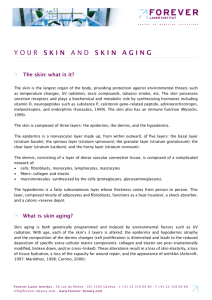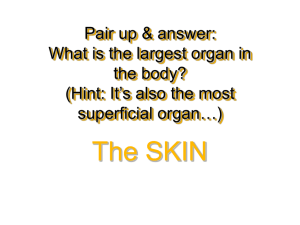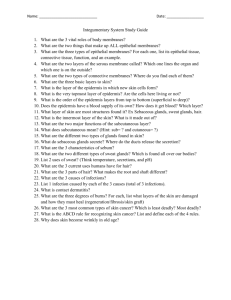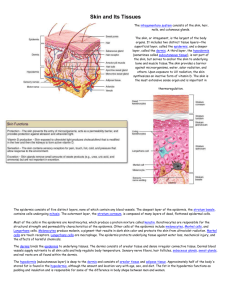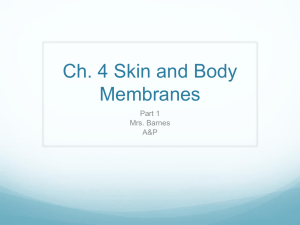Integumentary System Guided Reading
advertisement
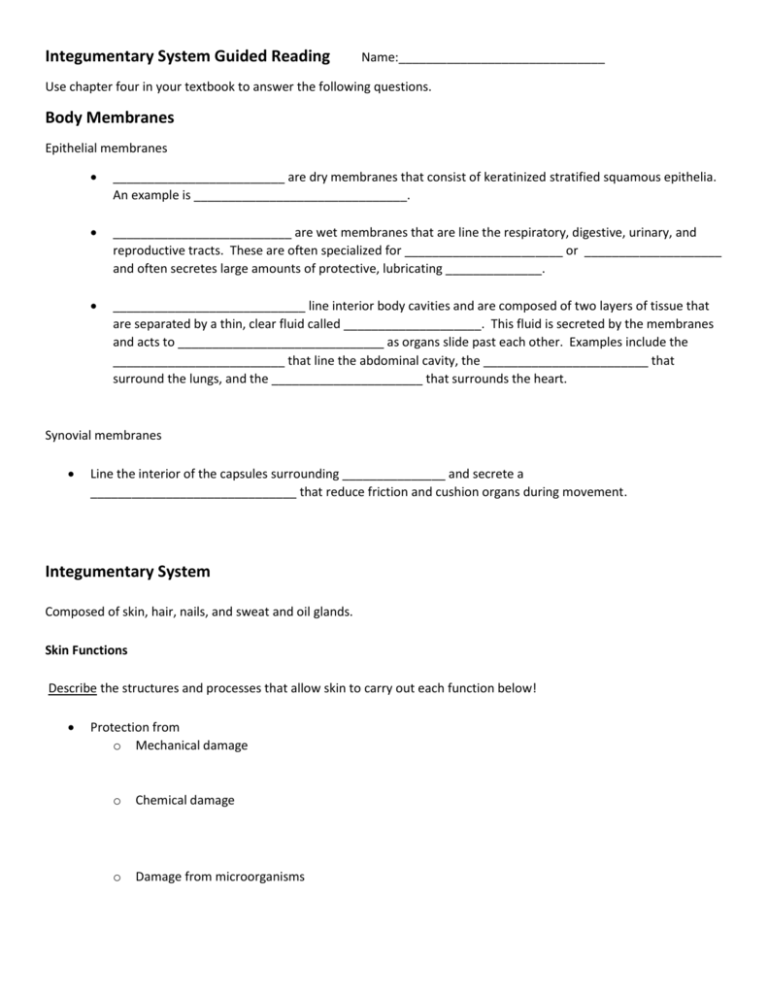
Integumentary System Guided Reading Name:______________________________ Use chapter four in your textbook to answer the following questions. Body Membranes Epithelial membranes _________________________ are dry membranes that consist of keratinized stratified squamous epithelia. An example is _______________________________. __________________________ are wet membranes that are line the respiratory, digestive, urinary, and reproductive tracts. These are often specialized for _______________________ or ____________________ and often secretes large amounts of protective, lubricating ______________. ____________________________ line interior body cavities and are composed of two layers of tissue that are separated by a thin, clear fluid called ____________________. This fluid is secreted by the membranes and acts to ______________________________ as organs slide past each other. Examples include the _________________________ that line the abdominal cavity, the ________________________ that surround the lungs, and the ______________________ that surrounds the heart. Synovial membranes Line the interior of the capsules surrounding _______________ and secrete a ______________________________ that reduce friction and cushion organs during movement. Integumentary System Composed of skin, hair, nails, and sweat and oil glands. Skin Functions Describe the structures and processes that allow skin to carry out each function below! Protection from o Mechanical damage o Chemical damage o Damage from microorganisms o Damage from UV radiation o Damage from heat / cold o Dessication Thermoregulation Excretion of wastes Synthesis of vitamin D. Skin Structure The skin is made of two structures. The superficial layer, called the _______________________, is composed of keratinized __________________________________________. Keratin is a protein that accumulates in this tissue, making the tissue tough and waterproof. The deep layer, called the ____________________, is made of ________________________________. Below the dermis is a tissue called the hypodermis. The hypodermis is composed mostly of ____________________ tissue and is not technically considered part of the skin. Vocab alert: Epi - means “on”, and Hypo- means ‘lower’. How does knowing the prefix help you remember the location of the three tissue types? Fun fact: _________________ occur when a burn or friction causes the epidermis to separate from the dermis. Epidermis The epidermis is composed of five layers or _____________. I am NOT requiring that you memorize the layers. However, I do want you to know the following: Only the cells in the deepest layer are actively growing, processing energy, and dividing. Why? Because epithelial tissue is ___________________, meaning that it lacks blood vessels. Only the deep epithelial cells are close enough to the blood vessels of the dermis to receive sufficient oxygen and nutrients for growth. As you move from deep to superficial layers of the epidermis, the cells atrophy (die) and become more and more flat, forming a thick, tough, waterproof barrier to the underlying tissues. There are two major cell types within the epidermis: ______________________________ which produce keratin, which makes the skin tough and water-resistant. _______________________________ which produce the pigment melanin. These are found in the deepest layers of the skin and serve to protect our body from _______________________. Dermis The dermis is composed of __________________ tissue. Connective tissue cushions and binds things together. In the skin, the connective tissue holds together lots of different elements: • Exocrine glands • Hair follicles • Nerves and sense receptors • Blood vessels As we learned earlier, connective tissues are composed of scattered cells in an extracellular matrix. The extracellular matrix of the skin is composed of a lot of ___________________________ and _____________________ fibers which give the skin is strength and elasticity. Fun fact: _______________________ occur because our skin loses collagen and elastic fibers and subcutaneous fat as we age. The dermis is also the part of the skin that is vitally important to thermoregulation. When our body temperature is too high, the capillaries become __________________________ allowing our body heat to be lost to the environment. When our body temperature is too low, the capillaries become ___________________________, helping conserve our body heat. Skin Color Our skin color is determined primarily by three things: 1. The amount and kind of __________________ in the epidermis. 2. The amount of ____________________ in the hypodermis. 3. The amount of _____________________ in the blood of the dermis. Why do we tan? Why do we blush? What is jaundice and why does it occur? What is cyanosis, and what does it look like in people with light skin? In people with dark skin? What is a bruise? Fun fact: People whose ancestors came from near the equator have darker skin (caused by a lot of ____________________) in order to protect their skin from UV damage. People whose ancestors came from northern latitudes with less sunlight have lighter skin (caused by less _____________________) in order to optimize vitamin D production. Diagram of human skin




